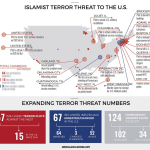Pope Francis will be visiting the United States after He completes his trip to Cuba on September 22. Pope Francis will include Washington D.C., New York (Madison Square Garden and Central Park) and Philadelphia on His agenda. During his time in New York, He will address the United Nations, make an appears at the 9/11 Memorial and Museum and Our Lady of Queen of Angels School in East Harlem.
At the core of His presentations, you can bet it will include refugees and immigration.
The back story and what you need to know.
President to decide on refugee quota for FY2016 NOW! Will Congress lift a finger to protect America?
It is September and as we speak, the Obama Administration (US State Department) is putting its final touches on their annual Determination Letter and accompanying report to Congress.
The new fiscal year begins on October 1 and by the 30th of this month Obama will send to Congress for “consultation” a document which states how many refugees and from what regions of the world we will be “welcoming” refugees to America.
This so-called “consultation” with Congress is a legal requirement. However, it is common knowledge that the House and Senate Committees responsible for analyzing this information have in the past been silent.
In fact, Ken Tota (who recently served as the interim director of the Office of Refugee Resettlement) was overheard saying that “in his entire almost 30-year career, Congress has never questioned the numbers.”
State Department scoping meetings
For our many new readers, this year there was no US State Department hearing on the “size and scope” of the refugee program (or, LOL! they kept it very secret!). We can only assume that was because in the three previous years they heard testimony that they didn’t like from citizens that were concerned about the program. Here is one post of dozens on the topic. Readers of RRW had flooded the State Department with negative testimony about the program. In fact, we testified that there should be a moratorium on the program. See my 2014 testimony here.
I mention this because the Presidential Determination being prepared now is the culmination of the annual process that began with those late spring ‘hearings’ (and again there was no public opportunity to comment this year that we were aware of).
Also, regular readers know that we have been discussing, and attempting to obtain, R & P abstracts the subcontractors located around the country prepare for Washington—those are part of the process as well. Just as taxpaying citizens had no opportunity to testify to the State Department this year, taxpaying citizens have no input in the abstract preparation process either.
Presumably one final check in the system to protect America is the “consultation” with Congress in September of each year.
However, if this year is like all others, our elected representatives in Washington will not lift a finger to question the size and scope of this year’s proposed refugee quota!
And, this could be the year that plans to resettle tens of thousands of Syrians will be announced!
Click here for last year’s Presidential Determination, and here for the lengthy report which was sent to Congress on September 18th last year. The report begins:
This Proposed Refugee Admissions for Fiscal Year 2015: Report to the Congress is submitted in compliance with Sections 207(d)(1) and (e) of the Immigration and Nationality Act (INA). The Act requires that before the start of the fiscal year and, to the extent possible, at least two weeks prior to consultations on refugee admissions, members of the Committees on the Judiciary of the Senate and the House of Representatives be provided with the following information….
Note that the report goes to the House and Senate Judiciary Committees. Chairmen of the full committees are Bob Goodlatte and Chuck Grassley respectively. Subcommittee Chairmen responsible for Refugee Resettlement are Trey Gowdy and Jeff Sessions.
Will those chairmen help protect America this year by holding hearings when the Presidential Determination for FY2016 arrives on the Hill which by law should be in about two weeks! Or, will they (yet again!) simply rubber stamp what Obama wants?


